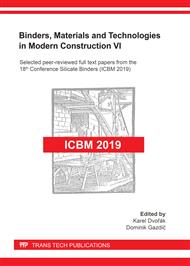p.3
p.9
p.15
p.23
p.29
p.37
p.45
p.51
Study of Development of Hydrating Temperatures and Reduction of Volume Changes in Concretes
Abstract:
One of the main characteristics in the concreting of massive waterproof structures and dam bodies is the prediction of crack formation. This prediction is associated with an understanding of the mechanics of development of hydration temperatures that affect in particular the selected binder parts of concrete. A suitable combination of cement with mineral admixtures, as well as the use of so-called shrinkage-reducing admixtures, seems to be an effective tool for influencing the dynamics of development and maximum values of hydration temperatures. Appropriate selection of the formula itself can significantly extend the lifetime of the mentioned structures. The paper is focused on monitoring the influence of different types of mineral admixtures on the effect of volume changes of cement pastes. The association of these volume changes with the development of hydration temperatures of these pastes was also observed. In order to minimize both of these phenomena, the possibility of using a shrinkage-reducing admixture was verified.
Info:
Periodical:
Pages:
3-8
Citation:
Online since:
July 2021
Authors:
Price:
Сopyright:
© 2021 Trans Tech Publications Ltd. All Rights Reserved
Share:
Citation:


